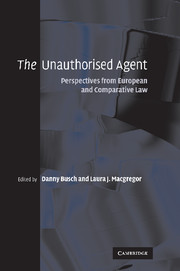Book contents
- Frontmatter
- Contents
- List of contributors
- Foreword
- Preface
- Abbreviations
- Table of cases
- 1 Introduction
- PART 1 The civilian legal systems
- PART 2 The common law
- 6 Unauthorised agency in English law
- 7 The Restatement (Third) of Agency and the unauthorised agent in US law
- 8 Unauthorised agency, the American Restatements and other common law countries
- PART 3 Mixed legal systems
- PART 4 International ‘codes’
- PART 5 Conclusions
- Bibliography
- Index
7 - The Restatement (Third) of Agency and the unauthorised agent in US law
Published online by Cambridge University Press: 07 September 2009
- Frontmatter
- Contents
- List of contributors
- Foreword
- Preface
- Abbreviations
- Table of cases
- 1 Introduction
- PART 1 The civilian legal systems
- PART 2 The common law
- 6 Unauthorised agency in English law
- 7 The Restatement (Third) of Agency and the unauthorised agent in US law
- 8 Unauthorised agency, the American Restatements and other common law countries
- PART 3 Mixed legal systems
- PART 4 International ‘codes’
- PART 5 Conclusions
- Bibliography
- Index
Summary
Introduction
Contemporary agency law in the United States reflects the dominant influence of a relatively uniform body of common law principles, applied in a context in which statutes and regulatory rules are also significant. Common law agency principles bring intellectual coherence to a legal landscape with potentially disparate features, many stemming from the federal structure of the United States. In six states, basic principles of agency were codified to some extent in the nineteenth and early twentieth centuries, for the most part reflecting then-contemporary common law. Louisiana's current codification of agency, adopted in 1997, draws to some extent on the Quebec Civil Code. Moreover, contemporary applications of common law agency principles often occur in a context in which other statutory material is highly relevant, as is inevitably so when an agent or a principal owes its legal personality to a statute's recognition of a particular type of organisational form, such as a corporation or a limited partnership.
The first and second Restatements of Agency have long dominated as statements of the foundational elements of common law agency doctrine in the United States. In part, their influence may be explained by the fact that, after 1914, the subject attracted no comprehensive account in a treatise. Restatement (Third) of Agency, although representing continuity with the earlier Restatements, also departs from their style, structure and substantive formulations in major ways.
- Type
- Chapter
- Information
- The Unauthorised AgentPerspectives from European and Comparative Law, pp. 219 - 244Publisher: Cambridge University PressPrint publication year: 2009
- 3
- Cited by

